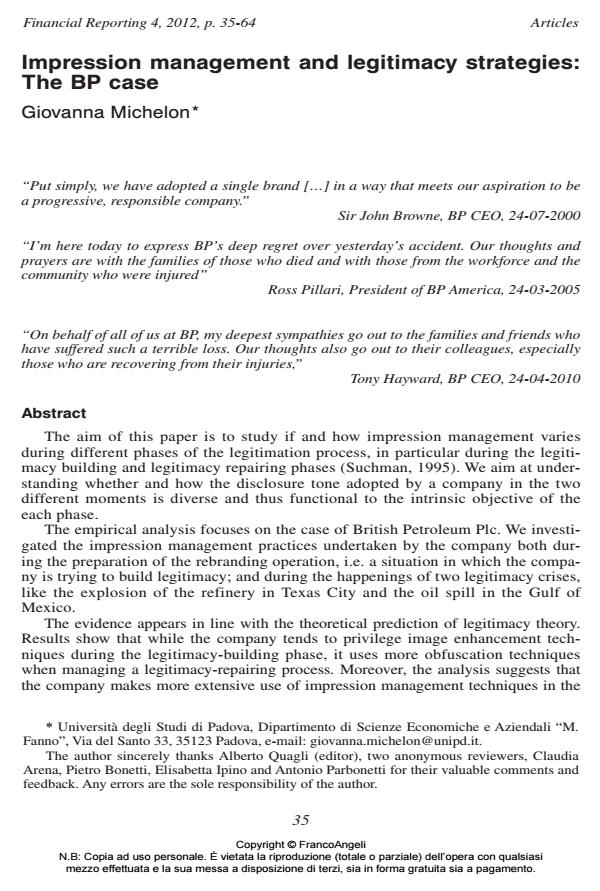Impression management and legitimacy strategies: The BP case
Titolo Rivista FINANCIAL REPORTING
Autori/Curatori Giovanna Michelon
Anno di pubblicazione 2013 Fascicolo 2012/4
Lingua Inglese Numero pagine 30 P. 35-64 Dimensione file 599 KB
DOI 10.3280/FR2012-004004
Il DOI è il codice a barre della proprietà intellettuale: per saperne di più
clicca qui
Qui sotto puoi vedere in anteprima la prima pagina di questo articolo.
Se questo articolo ti interessa, lo puoi acquistare (e scaricare in formato pdf) seguendo le facili indicazioni per acquistare il download credit. Acquista Download Credits per scaricare questo Articolo in formato PDF

FrancoAngeli è membro della Publishers International Linking Association, Inc (PILA)associazione indipendente e non profit per facilitare (attraverso i servizi tecnologici implementati da CrossRef.org) l’accesso degli studiosi ai contenuti digitali nelle pubblicazioni professionali e scientifiche
The aim of this paper is to study if and how impression management varies during different phases of the legitimation process, in particular during the legitimacy building and legitimacy repairing phases (Suchman, 1995). We aim at understanding whether and how the disclosure tone adopted by a company in the two different moments is diverse and thus functional to the intrinsic objective of the each phase. The empirical analysis focuses on the case of British Petroleum Plc. We investigated the impression management practices undertaken by the company both during the preparation of the rebranding operation, i.e. a situation in which the company is trying to build legitimacy; and during the happenings of two legitimacy crises, like the explosion of the refinery in Texas City and the oil spill in the Gulf of Mexico. The evidence appears in line with the theoretical prediction of legitimacy theory. Results show that while the company tends to privilege image enhancement techniques during the legitimacy-building phase, it uses more obfuscation techniques when managing a legitimacy-repairing process. Moreover, the analysis suggests that the company makes more extensive use of impression management techniques in the disclosures addressed to shareholders, investors and other market operators than in the disclosures addressed to the wide range of other stakeholders.
Parole chiave:Impression management, disclosure tone, legitimacy building, legitimacy crisis.
- Graphical Reporting in Italian Annual Reports during the Financial Crisis: Impression Management or Incremental Information? Simone Aresu, in FINANCIAL REPORTING 1/2015 pp.77
DOI: 10.3280/FR2015-001004 - The frontstage-backstage of organizational identity and management control system: the tale of British Petroleum’s embarrassment in DWH Sameh Farhat Ammar, in Sustainability Accounting, Management and Policy Journal /2024 pp.265
DOI: 10.1108/SAMPJ-11-2022-0584 - Circular economy in the food industry. An analysis of Italian-listed companies' sustainability reports Raffaela Nastari, Sabrina Pisano, Matteo Pozzoli, in FINANCIAL REPORTING 1/2025 pp.81
DOI: 10.3280/fr202516707 - GRI Application Levels and Disclosure on Specific Environmental Activities: An Empirical Investigation of Industry Membership and Geographical Region of Top European Companies Abeer Hassan, Colette Hunter, Ayodele Asekomeh, in Social and Environmental Accountability Journal /2013 pp.156
DOI: 10.1080/0969160X.2013.840539 - Antenarration et communication financière : leçons de l’opération Areva/UraMin Véronique Blum, Bernard Gumb, in Comptabilité Contrôle Audit /2016 pp.77
DOI: 10.3917/cca.222.0077 - Is risk reporting a possible link between financial and management accounting in private firms? Chiara Crovini, Giovanni Ossola, in FINANCIAL REPORTING 1/2021 pp.29
DOI: 10.3280/FR2021-001002
Giovanna Michelon, Impression management and legitimacy strategies: The BP case in "FINANCIAL REPORTING" 4/2012, pp 35-64, DOI: 10.3280/FR2012-004004